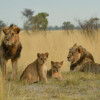
Unravel the unique complexities and fascinating dynamics of social hierarchies in the animal kingdom. This comprehensive exploration brings to life the nuances of these intricate arrangements, as well as their significant impact on survival and evolution.
The Essence of Social Hierarchies in Animal Kingdom
At the core of every animal society, there exists a well-structured order that dictates the behaviors and interactions among its members. Often known as a social hierarchy, this system is driven by powerful elements such as dominance, subordination, cooperation, and competition. It breeds a vast range of dynamics from complex alliances and power plays in primates, to the intriguing queen-led colonies of insects, to the packs of carnivores in the wilderness. These intricate systems have drawn the attention of zoologists, evolutionary biologists, and behavioral ecologists who aim to shed more light on the numerous facets involved.
Dominance Hierarchies: A Display of Power and Control
Understanding social hierarchies begins with deciphering the dominance structures. These hierarchies, often referred to as 'pecking orders', are particularly significant among species that live in large group settings. Those that showcase strength, successful aggressive tactics or inherited superiority lay claim to the highest ranks. These dominant individuals typically enjoy numerous benefits including priority access to food, breeding opportunities, and prime habitats. In turn, this aids in increasing their chances of survival and reproduction, thereby strongly influencing the evolutionary processes. Among the ranks, they enforce order, reduce the need for aggressive confrontations, and maintain harmony within the society.
Cooperation and Safety: The Evolution of Group Dynamics
Survival in the animal kingdom is often rooted in the security that large groups provide. Many species, such as meerkats, elephants, and dolphins, thrive due to their collaborative social systems. For instance, meerkats engage in cooperative breeding. The dominant pair leads the group and reproduces, while non-breeding members help raise the young and stand guard against predators. In elephant herds, the eldest and most experienced female, known as the matriarch, guides and protects the group while imparting crucial survival skills. Dolphins, well-renowned for their intelligence, demonstrate high levels of communication and teamwork during hunting. Such cooperative systems have significant implications on the survival and functioning of these species.
The Puzzling World of Insect Social Hierarchies
Nothing short of a marvel, insect societies, predominantly bees, ants, termites, and some species of wasps, exhibit one of the most complex and highly coordinated systems in the animal kingdom. Ranging from the egg-laying queen, diligent worker insects to the drones, each member has its unique role and position within the colony. All answering to the queen, the highest-ranking member, these societies demonstrate specialized division of labor, intricate communication systems, and cooperation on a massive scale. These eusocial insects, with their rich, layered hierarchies, provide fascinating insights into the mechanisms of social evolution.
The Environmental Implications of Animal Social Structures
Animal social organization significantly impacts ecological balance. Predatory species with hierarchical systems often exhibit top-down control in the ecosystem, influencing the population of prey species and thereby maintaining biodiversity. Similarly, eusocial insect societies contribute to soil formation and aeration, seed dispersal, and pollination, playing a crucial role in the proper functioning of ecosystems. However, human interference and climate changes pose threats to these species and their social structures, bearing far-reaching consequences on the planet's ecosystems.
















